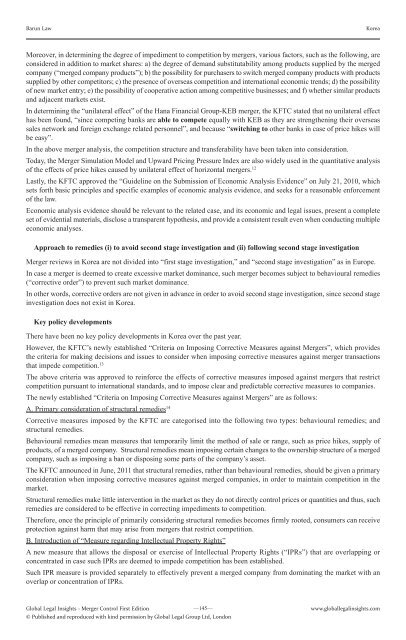Merger Controls First Edition - J Sagar Associates
Merger Controls First Edition - J Sagar Associates
Merger Controls First Edition - J Sagar Associates
Create successful ePaper yourself
Turn your PDF publications into a flip-book with our unique Google optimized e-Paper software.
Barun Law Korea<br />
Moreover, in determining the degree of impediment to competition by mergers, various factors, such as the following, are<br />
considered in addition to market shares: a) the degree of demand substitutability among products supplied by the merged<br />
company (“merged company products”); b) the possibility for purchasers to switch merged company products with products<br />
supplied by other competitors; c) the presence of overseas competition and international economic trends; d) the possibility<br />
of new market entry; e) the possibility of cooperative action among competitive businesses; and f) whether similar products<br />
and adjacent markets exist.<br />
In determining the “unilateral effect” of the Hana Financial Group-KEB merger, the KFTC stated that no unilateral effect<br />
has been found, “since competing banks are able to compete equally with KEB as they are strengthening their overseas<br />
sales network and foreign exchange related personnel”, and because “switching to other banks in case of price hikes will<br />
be easy”.<br />
In the above merger analysis, the competition structure and transferability have been taken into consideration.<br />
Today, the <strong>Merger</strong> Simulation Model and Upward Pricing Pressure Index are also widely used in the quantitative analysis<br />
of the effects of price hikes caused by unilateral effect of horizontal mergers. 12<br />
Lastly, the KFTC approved the “Guideline on the Submission of Economic Analysis Evidence” on July 21, 2010, which<br />
sets forth basic principles and specific examples of economic analysis evidence, and seeks for a reasonable enforcement<br />
of the law.<br />
Economic analysis evidence should be relevant to the related case, and its economic and legal issues, present a complete<br />
set of evidential materials, disclose a transparent hypothesis, and provide a consistent result even when conducting multiple<br />
economic analyses.<br />
Approach to remedies (i) to avoid second stage investigation and (ii) following second stage investigation<br />
<strong>Merger</strong> reviews in Korea are not divided into “first stage investigation,” and “second stage investigation” as in Europe.<br />
In case a merger is deemed to create excessive market dominance, such merger becomes subject to behavioural remedies<br />
(“corrective order”) to prevent such market dominance.<br />
In other words, corrective orders are not given in advance in order to avoid second stage investigation, since second stage<br />
investigation does not exist in Korea.<br />
Key policy developments<br />
There have been no key policy developments in Korea over the past year.<br />
However, the KFTC’s newly established “Criteria on Imposing Corrective Measures against <strong>Merger</strong>s”, which provides<br />
the criteria for making decisions and issues to consider when imposing corrective measures against merger transactions<br />
that impede competition. 13<br />
The above criteria was approved to reinforce the effects of corrective measures imposed against mergers that restrict<br />
competition pursuant to international standards, and to impose clear and predictable corrective measures to companies.<br />
The newly established “Criteria on Imposing Corrective Measures against <strong>Merger</strong>s” are as follows:<br />
A. Primary consideration of structural remedies14 Corrective measures imposed by the KFTC are categorised into the following two types: behavioural remedies; and<br />
structural remedies.<br />
Behavioural remedies mean measures that temporarily limit the method of sale or range, such as price hikes, supply of<br />
products, of a merged company. Structural remedies mean imposing certain changes to the ownership structure of a merged<br />
company, such as imposing a ban or disposing some parts of the company’s asset.<br />
The KFTC announced in June, 2011 that structural remedies, rather than behavioural remedies, should be given a primary<br />
consideration when imposing corrective measures against merged companies, in order to maintain competition in the<br />
market.<br />
Structural remedies make little intervention in the market as they do not directly control prices or quantities and thus, such<br />
remedies are considered to be effective in correcting impediments to competition.<br />
Therefore, once the principle of primarily considering structural remedies becomes firmly rooted, consumers can receive<br />
protection against harm that may arise from mergers that restrict competition.<br />
B. Introduction of “Measure regarding Intellectual Property Rights”<br />
A new measure that allows the disposal or exercise of Intellectual Property Rights (“IPRs”) that are overlapping or<br />
concentrated in case such IPRs are deemed to impede competition has been established.<br />
Such IPR measure is provided separately to effectively prevent a merged company from dominating the market with an<br />
overlap or concentration of IPRs.<br />
Global Legal Insights <strong>Merger</strong> Control <strong>First</strong> <strong>Edition</strong><br />
—145—<br />
© Published and reproduced with kind permission by Global Legal Group Ltd, London<br />
www.globallegalinsights.com


